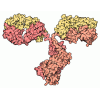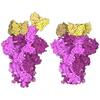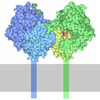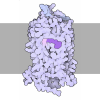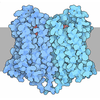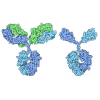[English] 日本語
 Yorodumi
Yorodumi- PDB-7sk6: Cryo-EM structure of human ACKR3 in complex with chemokine N-term... -
+ Open data
Open data
- Basic information
Basic information
| Entry | Database: PDB / ID: 7sk6 | ||||||||||||||||||||||||
|---|---|---|---|---|---|---|---|---|---|---|---|---|---|---|---|---|---|---|---|---|---|---|---|---|---|
| Title | Cryo-EM structure of human ACKR3 in complex with chemokine N-terminal mutant CXCL12_LRHQ and an intracellular Fab | ||||||||||||||||||||||||
 Components Components |
| ||||||||||||||||||||||||
 Keywords Keywords | SIGNALING PROTEIN / Atypical Chemokine Receptor / MEMBRANE PROTEIN | ||||||||||||||||||||||||
| Function / homology |  Function and homology information Function and homology informationoculomotor nerve development / positive regulation of mesenchymal stem cell migration / telencephalon cell migration / chemokine (C-X-C motif) ligand 12 signaling pathway / negative regulation of leukocyte tethering or rolling / response to ultrasound / regulation of actin polymerization or depolymerization / chemokine receptor binding / C-X-C chemokine binding / CXCL12-activated CXCR4 signaling pathway ...oculomotor nerve development / positive regulation of mesenchymal stem cell migration / telencephalon cell migration / chemokine (C-X-C motif) ligand 12 signaling pathway / negative regulation of leukocyte tethering or rolling / response to ultrasound / regulation of actin polymerization or depolymerization / chemokine receptor binding / C-X-C chemokine binding / CXCL12-activated CXCR4 signaling pathway / CXCR chemokine receptor binding / C-X-C chemokine receptor activity / positive regulation of axon extension involved in axon guidance / positive regulation of vasculature development / positive regulation of dopamine secretion / Signaling by ROBO receptors / induction of positive chemotaxis / integrin activation / negative regulation of dendritic cell apoptotic process / C-C chemokine receptor activity / negative regulation of intrinsic apoptotic signaling pathway in response to DNA damage / cellular response to chemokine / chemokine-mediated signaling pathway / C-C chemokine binding / positive regulation of monocyte chemotaxis / chemokine activity / blood circulation / Chemokine receptors bind chemokines / scavenger receptor activity / positive regulation of calcium ion import / detection of temperature stimulus involved in sensory perception of pain / animal organ regeneration / detection of mechanical stimulus involved in sensory perception of pain / positive regulation of T cell migration / vasculogenesis / Nuclear signaling by ERBB4 / coreceptor activity / clathrin-coated pit / positive regulation of endothelial cell proliferation / positive regulation of neuron differentiation / positive regulation of cell adhesion / axon guidance / adult locomotory behavior / cell chemotaxis / growth factor activity / calcium-mediated signaling / defense response / response to peptide hormone / recycling endosome / receptor internalization / response to virus / integrin binding / neuron migration / intracellular calcium ion homeostasis / chemotaxis / : / positive regulation of cytosolic calcium ion concentration / angiogenesis / G alpha (i) signalling events / Estrogen-dependent gene expression / early endosome / response to hypoxia / positive regulation of ERK1 and ERK2 cascade / cell adhesion / endosome / immune response / positive regulation of cell migration / G protein-coupled receptor signaling pathway / signaling receptor binding / negative regulation of cell population proliferation / external side of plasma membrane / intracellular membrane-bounded organelle / cell surface / signal transduction / extracellular exosome / extracellular region / plasma membrane Similarity search - Function | ||||||||||||||||||||||||
| Biological species |  Homo sapiens (human) Homo sapiens (human) | ||||||||||||||||||||||||
| Method | ELECTRON MICROSCOPY / single particle reconstruction / cryo EM / Resolution: 4 Å | ||||||||||||||||||||||||
 Authors Authors | Yen, Y.C. / Schafer, C.T. / Gustavsson, M. / Handel, T.M. / Tesmer, J.J.G. | ||||||||||||||||||||||||
| Funding support |  United States, 7items United States, 7items
| ||||||||||||||||||||||||
 Citation Citation |  Journal: Sci Adv / Year: 2022 Journal: Sci Adv / Year: 2022Title: Structures of atypical chemokine receptor 3 reveal the basis for its promiscuity and signaling bias. Authors: Yu-Chen Yen / Christopher T Schafer / Martin Gustavsson / Stefanie A Eberle / Pawel K Dominik / Dawid Deneka / Penglie Zhang / Thomas J Schall / Anthony A Kossiakoff / John J G Tesmer / Tracy M Handel /    Abstract: Both CXC chemokine receptor 4 (CXCR4) and atypical chemokine receptor 3 (ACKR3) are activated by the chemokine CXCL12 yet evoke distinct cellular responses. CXCR4 is a canonical G protein-coupled ...Both CXC chemokine receptor 4 (CXCR4) and atypical chemokine receptor 3 (ACKR3) are activated by the chemokine CXCL12 yet evoke distinct cellular responses. CXCR4 is a canonical G protein-coupled receptor (GPCR), whereas ACKR3 is intrinsically biased for arrestin. The molecular basis for this difference is not understood. Here, we describe cryo-EM structures of ACKR3 in complex with CXCL12, a more potent CXCL12 variant, and a small-molecule agonist. The bound chemokines adopt an unexpected pose relative to those established for CXCR4 and observed in other receptor-chemokine complexes. Along with functional studies, these structures provide insight into the ligand-binding promiscuity of ACKR3, why it fails to couple to G proteins, and its bias toward β-arrestin. The results lay the groundwork for understanding the physiological interplay of ACKR3 with other GPCRs. | ||||||||||||||||||||||||
| History |
|
- Structure visualization
Structure visualization
| Structure viewer | Molecule:  Molmil Molmil Jmol/JSmol Jmol/JSmol |
|---|
- Downloads & links
Downloads & links
- Download
Download
| PDBx/mmCIF format |  7sk6.cif.gz 7sk6.cif.gz | 205.8 KB | Display |  PDBx/mmCIF format PDBx/mmCIF format |
|---|---|---|---|---|
| PDB format |  pdb7sk6.ent.gz pdb7sk6.ent.gz | 157.9 KB | Display |  PDB format PDB format |
| PDBx/mmJSON format |  7sk6.json.gz 7sk6.json.gz | Tree view |  PDBx/mmJSON format PDBx/mmJSON format | |
| Others |  Other downloads Other downloads |
-Validation report
| Summary document |  7sk6_validation.pdf.gz 7sk6_validation.pdf.gz | 815.8 KB | Display |  wwPDB validaton report wwPDB validaton report |
|---|---|---|---|---|
| Full document |  7sk6_full_validation.pdf.gz 7sk6_full_validation.pdf.gz | 816.3 KB | Display | |
| Data in XML |  7sk6_validation.xml.gz 7sk6_validation.xml.gz | 27.8 KB | Display | |
| Data in CIF |  7sk6_validation.cif.gz 7sk6_validation.cif.gz | 40.5 KB | Display | |
| Arichive directory |  https://data.pdbj.org/pub/pdb/validation_reports/sk/7sk6 https://data.pdbj.org/pub/pdb/validation_reports/sk/7sk6 ftp://data.pdbj.org/pub/pdb/validation_reports/sk/7sk6 ftp://data.pdbj.org/pub/pdb/validation_reports/sk/7sk6 | HTTPS FTP |
-Related structure data
| Related structure data |  25174MC 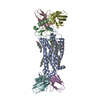 7sk3C  7sk4C 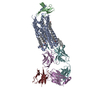 7sk5C 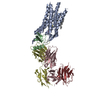 7sk7C 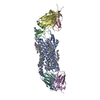 7sk8C 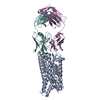 7sk9C M: map data used to model this data C: citing same article ( |
|---|---|
| Similar structure data | Similarity search - Function & homology  F&H Search F&H Search |
- Links
Links
- Assembly
Assembly
| Deposited unit | 
|
|---|---|
| 1 |
|
- Components
Components
| #1: Protein | Mass: 45196.406 Da / Num. of mol.: 1 Source method: isolated from a genetically manipulated source Source: (gene. exp.)  Homo sapiens (human) / Gene: ACKR3, CMKOR1, CXCR7, GPR159, RDC1 / Production host: Homo sapiens (human) / Gene: ACKR3, CMKOR1, CXCR7, GPR159, RDC1 / Production host:  |
|---|---|
| #2: Protein | Mass: 8189.663 Da / Num. of mol.: 1 / Mutation: N-terminus of CXCL12 (KPV) substituted with LRHQ Source method: isolated from a genetically manipulated source Source: (gene. exp.)  Homo sapiens (human) / Gene: CXCL12, SDF1, SDF1A, SDF1B Homo sapiens (human) / Gene: CXCL12, SDF1, SDF1A, SDF1BProduction host:  References: UniProt: P48061 |
| #3: Antibody | Mass: 23471.031 Da / Num. of mol.: 1 Source method: isolated from a genetically manipulated source Source: (gene. exp.)  Homo sapiens (human) Homo sapiens (human)Production host:  |
| #4: Antibody | Mass: 25380.223 Da / Num. of mol.: 1 Source method: isolated from a genetically manipulated source Source: (gene. exp.)  Homo sapiens (human) Homo sapiens (human)Production host:  |
| Has protein modification | Y |
-Experimental details
-Experiment
| Experiment | Method: ELECTRON MICROSCOPY |
|---|---|
| EM experiment | Aggregation state: PARTICLE / 3D reconstruction method: single particle reconstruction |
- Sample preparation
Sample preparation
| Component | Name: Complex structure of ACKR3-CXCL12_LRHQ- CID24 / Type: COMPLEX / Entity ID: all / Source: MULTIPLE SOURCES | |||||||||||||||||||||||||
|---|---|---|---|---|---|---|---|---|---|---|---|---|---|---|---|---|---|---|---|---|---|---|---|---|---|---|
| Molecular weight | Experimental value: NO | |||||||||||||||||||||||||
| Source (natural) | Organism:  Homo sapiens (human) Homo sapiens (human) | |||||||||||||||||||||||||
| Buffer solution | pH: 8 | |||||||||||||||||||||||||
| Buffer component |
| |||||||||||||||||||||||||
| Specimen | Conc.: 0.2 mg/ml / Embedding applied: NO / Shadowing applied: NO / Staining applied: NO / Vitrification applied: YES | |||||||||||||||||||||||||
| Specimen support | Grid material: COPPER / Grid mesh size: 300 divisions/in. / Grid type: Quantifoil R1.2/1.3 | |||||||||||||||||||||||||
| Vitrification | Instrument: FEI VITROBOT MARK IV / Cryogen name: ETHANE / Humidity: 100 % / Chamber temperature: 277 K |
- Electron microscopy imaging
Electron microscopy imaging
| Experimental equipment |  Model: Titan Krios / Image courtesy: FEI Company |
|---|---|
| Microscopy | Model: FEI TITAN KRIOS |
| Electron gun | Electron source:  FIELD EMISSION GUN / Accelerating voltage: 300 kV / Illumination mode: FLOOD BEAM FIELD EMISSION GUN / Accelerating voltage: 300 kV / Illumination mode: FLOOD BEAM |
| Electron lens | Mode: BRIGHT FIELD / Cs: 2.7 mm / C2 aperture diameter: 100 µm |
| Specimen holder | Cryogen: NITROGEN / Specimen holder model: FEI TITAN KRIOS AUTOGRID HOLDER |
| Image recording | Electron dose: 53.8 e/Å2 / Film or detector model: GATAN K3 (6k x 4k) |
- Processing
Processing
| EM software |
| |||||||||||||||||||||
|---|---|---|---|---|---|---|---|---|---|---|---|---|---|---|---|---|---|---|---|---|---|---|
| CTF correction | Type: PHASE FLIPPING AND AMPLITUDE CORRECTION | |||||||||||||||||||||
| Symmetry | Point symmetry: C1 (asymmetric) | |||||||||||||||||||||
| 3D reconstruction | Resolution: 4 Å / Resolution method: FSC 0.143 CUT-OFF / Num. of particles: 322105 / Symmetry type: POINT |
 Movie
Movie Controller
Controller








 PDBj
PDBj